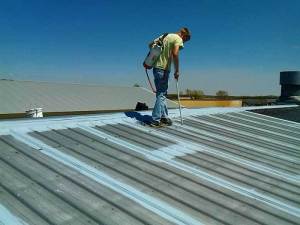Roof Coatings Frisco Texas
One of the fastest growing segments in the Commercial Roofing world is Fluid Applied coatings. According to the ChemQuest Group, the market for the polymer-based roof coatings is estimated to be $500-$550 million. These roof coating can be applied to sloped metal roofs and to low slope BUR, Modified Bitumen and single Ply membranes.

There are many benefits to using a roof coating system:
- Reflective. White cool roofs help reflect harmful ultraviolet radiation away from the roof. This extends the life of the roof by reducing heat transfer into the building thus decreasing thermal shock (expansion and contraction).
- Cost. Roof coatings are more economical than any of your other roofing options, but especially if you have to tear off an existing roof system. Provided the roof substrate has not been compromised and is in good order, roof coatings are less than half the cost.
- Durability. Unlike a polymer like asphalt, the asphalt absorbs some of the radiation and then the polymer begins to vibrate and break up into smaller pieces. The degradation done by the sunlight is obvious on asphalt roofs. However Acrylic polymers are transparent to ultraviolet radiation which means they do not absorb the sun’s destructive radiation. The polymer is not absorbing any of the radiation, it’s reflecting the radiation back into the atmosphere. Also roof coatings are elastomeric, meaning they can move with the expansion and contraction of the roof.
- Ease of Application. Of all roofing systems, roof coatings are by far the easiest and fastest to apply. Roof coatings can be applied by spray, roller, brush or squeegee. Also with a roof coating system you are spared the disruption of the tear off required for some other roofing applications.
- No seams. Unlike single play and torch down, there are no seams in roof coatings. Whether in single ply, torch down or on a metal roof, seams and penetrations are by far the most likely culprit for leaks.
- Sustainability. One of the best advantages for roof coatings is when needed another coating can be applied. The building owner can continue to have a new warranty endlessly with this approach. This is not possible with any other roofing system.
In the roof coating world you have several options. There are options for the type of elastomeric coating, such as Acrylic or Silicone and options for fully fabric reinforced or partial fabric reinforced.
Here are some of the basic options for Elastomeric coatings:
- Silicone and Urethane coating. These coatings are generally more expensive than the other elastomeric coatings, but they offer additional benefits, including enhanced resistance to chemical fallout, ponding water, heat, ultraviolet radiation and foot traffic. Silicone will not decay, chalk or crack under intense UV rays. A big drawback to silicone is that it cannot be recoated with any other liquid products and the re-coating with the same silicone generally involves a cumbersome process.
- Acrylic. These are water based products and enjoy the largest share of the elastomeric market. These coatings comply with increasingly stringent solvent emission regulations and represent a lower cost alternative to other polymers. Acrylics can be used for metal roofs and flat/low slope roofs.
Here are the two primary ways fabric mat is used in Roof Coatings:
- Partial mat. This is specifically done on metal roofs. A polyester mat is 3 coursed in on all horizontal seams and sometimes on the vertical seams. The mat is also used around all roof penetrations. This same method is done with using acrylic coating on a Mod Bit roof. The mat is applied to the Mod Bit seams and around all roof penetrations.
- Full mat. In this system, a base coat is applied and then a mat is inserted in the wet base coat. A second coat is then applied to the mat.
There are other options in Roof Coatings, but these basics cover the majority of applications used today.



